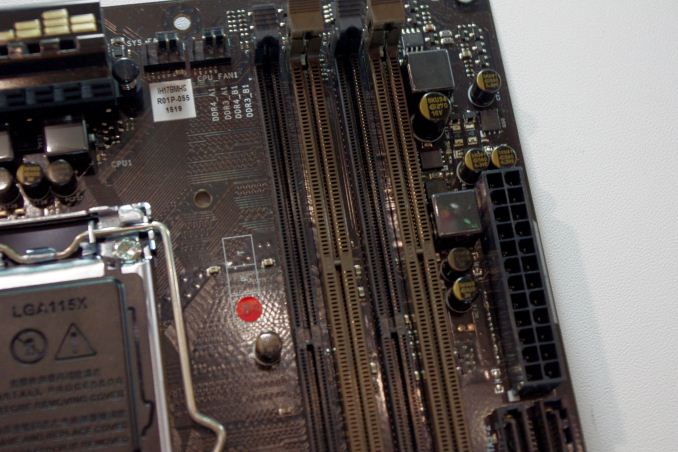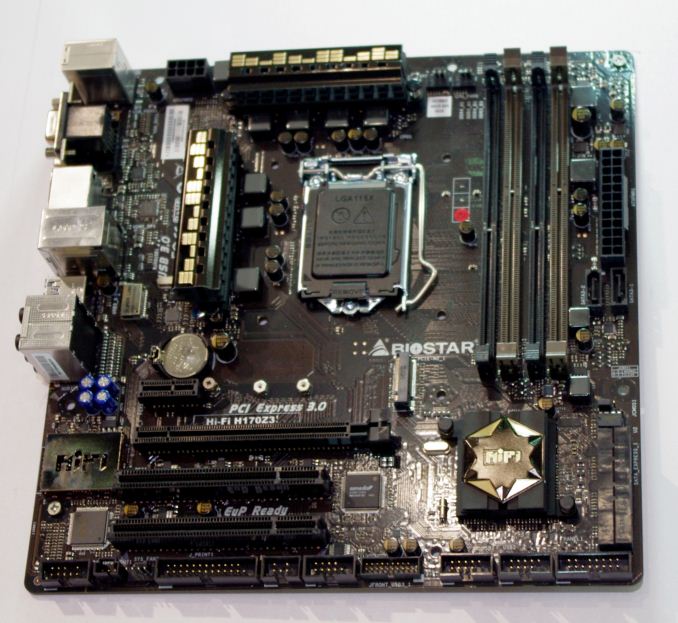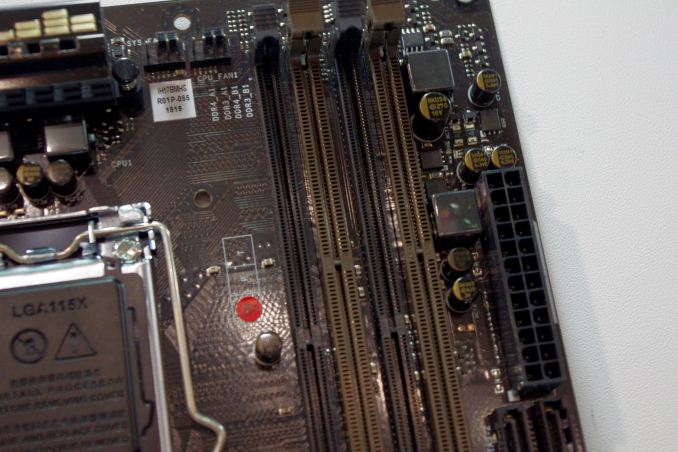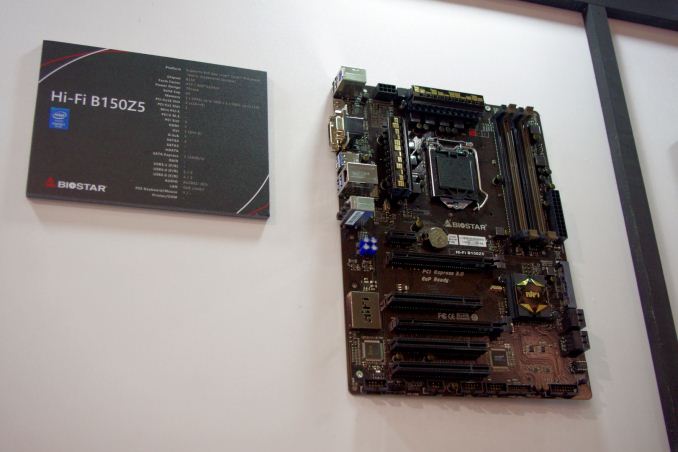Motherboards with DDR3L and DDR4: Biostar
by Ian Cutress on July 2, 2015 4:00 PM EST- Posted in
- Motherboards
- Biostar
- DDR4
- DDR3L
- Skylake
- 100-Series
- H170
- B150

With Intel’s latest extreme platform, Haswell-E and X99, supporting DDR4, all fingers have been pointing towards the state of DDR4 support for the 100-series motherboards and Intel’s 6th generation of processors, Skylake. At Computex we saw a number of 100-series motherboards, although I want to point out a couple which showcase a little of the DRAM support we should expect.
At the Biostar booth there was a H170 motherboard and a B150 motherboard that had clearly defined DDR3 and DDR4 memory slots:
The H170Z3 in show looks similar to a standard mATX motherboard using a single PCIe 3.0 x16, a couple of PCI slots, support for USB 3.0, SATA Express and M.2. It’s the DRAM slots with different spacing that act as the giveaway:
Note at the motherboard it states DDR3_A1 and DDR4_A1. Further questioning at the booth gave us two tidbits of information. Firstly, DDR3 is technically DDR3L, because the 1.35V requirement of DDR3L aligns better with the 1.2V (or 1.35V of high speed) DDR4 requirement. Regular DDR3 may work, though chances are it will not be tested. The other point of information was to be expected, because it mirrors that of the previous changeover – DDR3 and DDR4 cannot be used at the same time. As a result, this motherboard is essentially a one DIMM per channel design, but allows users an upgrade path if they already own DDR3L.
A full sized ATX-based B150Z5 with both DDR3 and DDR4 slots was also on show. It would seem (looking at the other motherboard manufacturers as well) that this type of hybrid design will not be on the Z170 series of motherboards, and is more resigned to the sub-$120 market. We would expect other manufacturers to come out with similar products as well.













32 Comments
View All Comments
biohazard918 - Thursday, July 2, 2015 - link
I am one of those people who want skylake but don't want to buy new ram but this board is unworkable for me I need 4 ddr3 ram slots for my 4 x 4gb dims. I also fail to see the point of having both ddr3 and ddr4 on the same board who is going to go out and buy ddr4 to replace there ddr3 and keep the same platform?DanNeely - Thursday, July 2, 2015 - link
Hope for a 4xDDR3 board then. IIRC none of the DDR1/DDR2 or DDR2/DDR3 board I've seen in the past had more than 4 dimm slots. Also, IIRC not seeing any high end boards with the dual ram config; they were all mid/low level models like the H170/B150 boards BioStar made.CuriousHomeBody - Friday, July 3, 2015 - link
I remember upgrading a very old system. Told them the old RAM was $400 and a new system with twice what I could install was on their old system was $700 at the time. They opted for the old ram to not have to change OS/software. In that situation This would have given them more RAM for a lot less.wavetrex - Thursday, July 2, 2015 - link
I have 32GB of DDR3 bought with my Ivy Bridge system 3 years ago. That will last me 5 more years at least in terms of memory consumption in games and non-professional applications.Why should I be forced to go to DDR4 if it doesn't provide any benefit (in either speed or capacity).
I'm happy such motherboards exists, and I really hope they still make them with DDR3 for quite a long time ...
LauRoman - Thursday, July 2, 2015 - link
I think this kind of budget board is aimed at OEMs. While building a system and they don't have some type of memory or they know that lot may have a lot of bad parts they may change to the other type of memory. This might not be true right now, but later when dd4 is a lot cheaper, or 3 gets as expensive as 2.blahsaysblah - Thursday, July 2, 2015 - link
What happened to UniDimm support with Skylake?https://en.wikipedia.org/wiki/UniDIMM
UniDIMM
From Wikipedia, the free encyclopedia
Two UniDIMM variants, with one of them having the same dimensions as DDR4 SO-DIMMs[1]:28
UniDIMM (short for Universal DIMM) is a specification for dual in-line memory modules (DIMMs), which are integrated circuits mounted on printed circuit boards (PCBs) and designed to carry dynamic random-access memory (DRAM). UniDIMM modules can be populated with either DDR3 or DDR4 chips, and the computer's memory controller must support both memory standards as UniDIMMs contain no additional memory control logic. The UniDIMM specification was created by Intel for its 2015 Skylake microarchitecture, whose integrated memory controller (IMC) is announced to support both DDR3 and DDR4 memory technologies.[2][3]
UniDIMM is a SO-DIMM form factor with dimensions of 69.6 mm × 30 mm (2.74 by 1.18 inches) for the standard version (which are the same as DDR4 SO-DIMM dimensions[4]), and 69.6 mm × 20 mm (2.74 by 0.79 inches) for the low-profile version.[5][1]:28 UniDIMM has a 260-pin edge connector (the same pin count as for DDR4 SO-DIMMs[4]), with the keying notch in a position that prevents wrong installation by making UniDIMMs physically incompatible with both standard DDR3 and standard DDR4 SO-DIMM sockets. As the DDR4 chips operate at a lower voltage than DDR3 chips (1.2 V versus 1.5 V), UniDIMM modules are designed to contain additional built-in voltage regulation circuitry.[2][1]:27–30
UniDIMM was designed to help the market transition from DDR3 to DDR4 SDRAM. As in previous RAM standard transitions, like from DDR2 to DDR3, there is a "chicken or the egg" problem – as a new product line, the new RAM standard is initially more expensive, yielding low demand and resulting in low production rates. During the DDR2 to DDR3 transition, this was sometimes handled by creating motherboards with separate slots for DDR2 and DDR3 modules, out of which only one set could be used.[6] By its design, UniDIMM specification allows either DDR3 or DDR4 memory to be used in the same memory slots, resulting in no wasted motherboard space that would otherwise be occupied by unused memory slots.[5]
As of September 2014, UniDIMM is not standardized by JEDEC,[2] with Kingston and Micron as the main supporters.[1]:28
extide - Thursday, July 2, 2015 - link
It never took off, although there is still a possibility it might .. we'll see.yuhong - Thursday, July 2, 2015 - link
Mobile only.Peeping Tom - Thursday, July 2, 2015 - link
Since the chip supports both DDR3/DDR4, why not have a single or dual slot interface that allows users to plug a RAM riser card depending on their choice of memory?yuhong - Thursday, July 2, 2015 - link
I don't think the plain DDR3/DDR2 interface is friendly to riser cards. Intel SMB used in Xeon E7 is.